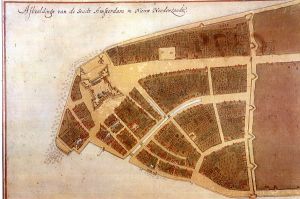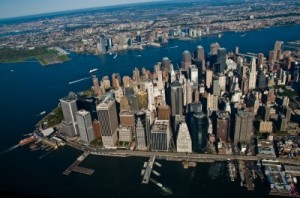New York’s cosmopolitan character has its roots in a history profoundly shaped by the Dutch merchants who first took control of the city’s territory and surroundings some 400 years ago. For when New Amsterdam (New York’s original name) gained the status of a city 363 years ago, it consisted of a settlement on the southern tip of Manhattan Island of about 800 inhabitants who already spoke 18 different native languages. Their major economic activity – trading in furs and slaves – seems to have brought this about:
The Dutch were the first to realise the commercial value of the Hudson Bay area and adjacent coastland early in the 17th century. From 1610 onwards Dutch explorers surveyed and mapped the area between the Delaware and the Connecticut Rivers, named it New Netherland and claimed it for the Dutch Republic.

Nova Belgica et Anglia Nova (New Netherland and New England) by Willem Blaeu (1571-1638), 1635.
Cosmopolitanism began when the first non-native American chose to stay and trade on Manhattan Island – he, however, was not a Dutch. Juan Rodriguez (also called João Rodrigues or Jan Rodrigues) was a young Dominican from Santo Domingo, son of a Portuguese sailor and an African mother, and apparently a good linguist as he worked as a translator for one of the Dutch explorers, Captain Thijs Mossel. When Mossel prepared to leave the Hudson Bay area to return home late in 1613, Rodriguez decided to stay and went ashore on Manhattan Island. There he began a life of trapping and trading, and learnt to live with the local Lenapes. For a long time forgotten, he is now acknowledged as New York’s first immigrant, African, Latino, Dominican, resident of European descent, and businessman, a truly symbolic figure for what New York would become. More about this first ‘New Yorker’ can be found here. In 2013, a three-mile Broadway stretch was given the name Juan Rodriguez Way.

The original city map of New Amsterdam called Castello Plan from 1660.
In 1521 the new Dutch West India Company was given a 24-year charter to exploit Dutch land in the west, including this region. Further trading posts were built along the coast, settlers were variably enticed to become the new tenants and by 1625 the settlement New Amsterdam had come into being on the southern shores of Manhattan Island (purchased form the Indians for the value of 60 Dutch Guilders in 1626). Soon slaves arriving via Brazil and later from Africa joined both the population and the merchandise on offer. Yet, a succession of inept and ruthless Director-Generals, sent by the West India Company, caused periods of unrest and population fluctuation, until in the late 1640s Peter Stuyvesant introduced the necessary stability for the community to prosper and grow. During his term as Director-General, New Amsterdam finally gained the municipal rights of a city in 1653 and was awarded its own seal.
All the while the English had never given up their own claim to the territory, and when Charles II came to the throne in 1660, he promised the whole of the Dutch territory to his brother, the Duke of York (the future James II). In 1664, deed followed the royal promise, and under the menace of 4 superior English warships in their harbour, the City of New Amsterdam peacefully surrendered on 8 September. In honour of the new proprietor, it was rechristened New York City, today the largest metropolis of the U.S.
The New Netherland Institute offers a tour through A Lost World. George J. Lankevich’s New York City: A Short History (New York: New York UP, 2002) describes in the first chapter how New Amsterdam became New York. You may enjoy doing this puzzle of Manhattan.

Photo by Nathan Siemers
